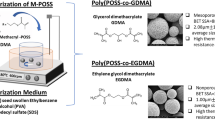Abstract
The fabrication of “switch-on” amphiphilic submicrometer hybrid particles of cross-linked polyethylene (XPE)@silica is described. The synthesis of the particles is based on the simultaneous cross-linking of PE and the polycondensation of tetraethoxysilane in hot, surfactant-stabilized O/W micelles. Thermal activation of the particles results in particles with amphiphilic behavior. It is proposed that the thermal activation triggers partial phase-separation which pushes some of the PE chain to the surface, in a heterogeneous way. By this, on each particle two halves can be identified which differ in their degree of hydrophobicity (“Janus” structure), thus giving rise to the surfactant activity. The particles were intensively characterized before and after the thermal activation and their amphiphilic behavior was demonstrated. By the approach described in the paper it is in principle possible to design a library of functionalities out of a single surface active agent species. This was demonstrated by the thermal activation of functionalized composite particles of dyes@XPE@silica and of the triple hybrid Ag@XPE@silica. Full material characterization is provided, including SEM, TGA, surface area analysis, antibacterial tests and zeta potential measurements.










Similar content being viewed by others
References
Bourgeat-Lami E (2007) Hybrid organic/inorganic particles, in hybrid materials: synthesis, characterization, and applications. Weinheim, Germany
Wegner G, Demir MM, Faatz M, Gorna K, Munoz-Espi R, Guillemet B, Groehn F (2007) Macromol Res 15:95
Sun XQ, Chen CM, Wang F (2010) Optica Applicata 40(3):737–745
Xu H, Yan F, Monson EE, Kopelman R (2003) J. Biomedical Mater Res PART A 66A(4):870–879
Watanabe M, Tamai T (2006) J Polym Sci PART A Polym Chem 44(16):4736–4742
Ramsden W (1903) Proc R Soc Lond 72:156–164
Pickering SU (1907) J Chem Soc Trans 91:2001–2021
De Gennes PG (1992) Rev Mod Phys 64:645–648
Walther Andreas HE, Mu¨ller A (2008) Soft Matter 4:663–668
Faria J, Ruiz MP, Resasco DE (2010) Adv Synth Catal 352(14–15):2359–2364
Tanaka T, Okayama M, Minami H, Okubo M (2010) Langmuir 26(14):11732–11736
Endresa KT, Beck-Broichsittera M, Samsonovaa O, Renettea T, Kissel TH (2011) Biomaterials 32(30):7721–7731
Teo BM, Suh Su K, Hatton TA, Ashokkumar M, Grieser F (2011) Langmuir 27(1):30–33
Vilain C, Goettmann F, Moores A, Le Floch P, Sanchez C (2007) J Mater Chem 17:3509–3514
Elimelech H, Nedelec JM, Babonneau F, Avnir D (2010) J Mater Chem 20:9515–9522
Sertchook H, Avnir D (2003) Chem Mater 15:1690–1694
Mokari T, Sertchook H, Aharoni A, Ebenstein Y, Avnir D, Banin U (2005) Chem Mater 17:258–263
Sertchook H, Elimelech H, Avnir D (2005) Chem Mater 17:4711–4716
Sertchook H, Elimelech H, Makarov C et al (2007) J Am Chem Soc 129(1):98–108
Makarov C, Khalfin RL, Makarov V, Cohen Y, Sertchook H, Elimelech H, Avnir D (2007) Polymer Adv Tech 18:712–719
Fucs I, Avnir D, master thesis, Hebrew University
Elimelech H, Avnir D (2008) Chem Mater 20(6):2224–2227
Zalzberg L, Avnir D (2008) J Sol-Gel Technol 48:47–50
Elimelech H, Avnir D (2012) RSC Adv 2(3):863–869
Naor H, Shuster M, Avnir D (2011) J Sol-Gel Sci Tech 59(1):194–203
Wilhelm P, Stephan D (2006) J Colloid Interface Sci 293:88
Jiang S, Chen Q, Tripathy M, Luijten E, Schweizer KS, Granick S (2010) Adv Mater 22:1060–1071
Avnir D, Kaufman VR, Reisfeld R (1985) J Non-Cryst Solids 74(2–3):395–406
Acknowledgments
Supported by NOFAR program for applied academic research in biotechnology and nano-technology of the Israel Ministry of Trade and Industry. Special thanks are due to Ms. Evgenia Blayvas and the staff at the Center of Nanoscience and Nanotechnology at the Hebrew University, and to Dr. Michael Shuster from Carmel Olefins.
Author information
Authors and Affiliations
Corresponding author
Rights and permissions
About this article
Cite this article
Naor, H., Elimelech, H. & Avnir, D. Thermal activation of polyethylene@silica particles: towards ceramic surfactants. J Sol-Gel Sci Technol 65, 74–82 (2013). https://doi.org/10.1007/s10971-012-2702-1
Received:
Accepted:
Published:
Issue Date:
DOI: https://doi.org/10.1007/s10971-012-2702-1




